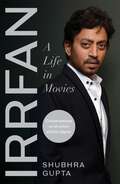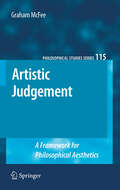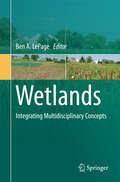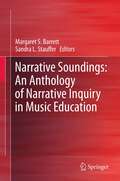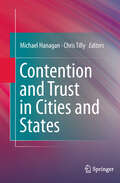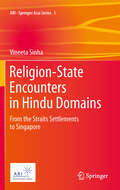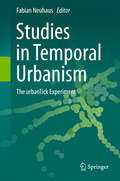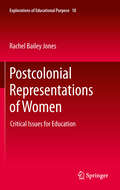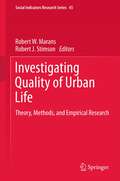- Table View
- List View
IRRFAN: A Life in Movies | Conversations on an Actor and His Legacy
by Shubhra GuptaAn eminent film critic engages Bollywood and beyond in conversation about Irrfan Khan’s art, craft, life and legacy.A spellbinding performer, Irrfan Khan was also a seeker who never stopped honing his skills, each new work a revelation, his oeuvre transformative for Hindi cinema. From his National School of Drama days to his nearly decade-long stint in television and subsequently his arrival in the movies, everyone who watched Irrfan knew they were in the presence of someone special. With his death from an incurable cancer, we lost an actor nonpareil. What is it that gave Irrfan, an ‘outsider’ to Bollywood, his distinction? What has been his contribution to cinema? How does one measure his legacy?Long-time film critic Shubhra Gupta asks these and other probing questions to members of the film fraternity who knew Irrfan, worked with him or observed him closely – Sutapa Sikdar, Shailja Kejriwal, Shyam Benegal, Tigmanshu Dhulia, Vishal Bhardwaj, Naseeruddin Shah, Mira Nair, Konkona Sen Sharma, Anup Singh, Tillotama Shome, Karan Johar, Anurag Kashyap, among several others. As they discuss Irrfan’s films, his craft, and his philosophy as an actor, what emerges is a deeply layered, complex and endlessly absorbing portrait of one of Indian cinema’s most influential artistes.Abuzz with a polyphony of perspectives on the actor and Hindi cinema at large, this is a rich collectible for Irrfan’s admirers and cinephiles alike.
Artistic Judgement: A Framework for Philosophical Aesthetics (Philosophical Studies Series #115)
by Graham McFeeArtistic Judgement sketches a framework for an account of art suitable to philosophical aesthetics. It stresses differences between artworks and other things; and locates the understanding of artworks both in a narrative of the history of art and in the institutional practices of the art world. Hence its distinctiveness lies in its strong account of the difference between, on the one hand, the judgement and appreciation of art and, on the other, the judgement and appreciation of all the other things in which we take an aesthetic interest. For only by acknowledging this contrast can one do justice to the importance regularly ascribed to art. The contrast is explained by appealing to an occasion-sensitive account of understanding, drawn from Charles Travis directly, but with Gordon Baker (and Wittgenstein) as also proximate rather than remote. On this basis, it argues, first, that we need to offer accounts of key topics only as far as questions might be raised in respect of them (hence, not exceptionlessly); and, second, that we should therefore defend the view that the meaning of artworks can be changed by later events (the historical character of art, or forward retroactivism) and that art has an institutional character, understood broadly on the lines of Terry Diffey’s Republic of Art. Besides providing a general framework, Artistic Judgement also explores the applications of the ideas to specific artworks or classes of them.
On Art and Artists: An Anthology of Diderot's Aesthetic Thought
by Denis DiderotChance ordained that Denis Diderot (1713-1784) was not only a philosopher, playwright and writer, but also a salonnier. In other words, an art critic. In 1759, his friend Grimm entrusted him with a project that forced him to acquire "thoughtful notions concerning painting and sculpture" and to refine "art terms, so familiar in his words yet so vague in his mind". Diderot wrote artistic reviews of exhibitions – Salons – that were organized bi-annually at the Louvre by the Académie Royale de Peinture et de Sculpture. These reviews, published in the Correspondence Littéraire, were Diderot’s unique contribution to art criticism in France. He fulfilled his task of salonnier on nine occasions, despite occasional dips in his enthusiasm and self-confidence. Compiled and presented by Jean Szenec, this anthology helps the contemporary reader to familiarize himself with Diderot’s aesthetic thought in all its greatness. It includes eight illustrations and is followed by texts from Jean Starobinski, Michel Delon, and Arthur Cohen. ‘On Art and Artists’ is translated by John Glaus, professor of French and an amateur expert of the XVIIIth century.
Eco-Urban Design
by John A. Flannery Karen M. Smith"Eco-Urban Design" focuses on the unprecedented challenges currently faced by architects and designers. In a world where climate change, diminishing natural resources and an increasing global population have become indisputable facts of life there is now a rising demand for evolved buildings that no longer endanger the Earth's fragile ecological systems.This book endeavours to tell the positive side of the story by featuring considered design solutions provided by the world's most innovative architects and engineers. By only including realised projects which have been subjected to post construction monitoring this publication provides evidence-based information that measured reductions in carbon emissions, water and energy usage can actually be achieved in the field and not just on the drawing board.These completed projects demonstrate best practice and will inspire a new hybrid generation of designers who will combine architecture and engineering skills to resolve a key environmental challenge. Furthermore, these creative construction projects from a variety of genres including, commercial property, public buildings, social housing and private homes give testimony to the fact that investment in green archineering also provides a commercial advantage to forward thinking developers and investors.
Late Cainozoic Floras of Iceland: 15 Million Years of Vegetation and Climate History in the Northern North Atlantic (Topics in Geobiology #35)
by Thomas Denk Friðgeir Grimsson Reinhard Zetter Leifur A. SímonarsonBeing the only place in the northern North Atlantic yielding late Cainozoic terrestrial sediments rich in plant fossils, Iceland provides a unique archive for vegetation and climate development in this region. This book includes the complete plant fossil record from Iceland spanning the past 15 million years. Eleven sedimentary rock formations containing over 320 plant taxa are described. For each flora, palaeoecology and floristic affinities within the Northern Hemisphere are established. The exceptional fossil record allows a deeper understanding of the role of the “North Atlantic Land Bridge” for intercontinental plant migration and of the Gulf Stream-North Atlantic Current system for regional climatic evolution.’Iceland sits as a “fossil trap” on one of the most interesting biogeographic exchange routes on the planet - the North Atlantic. The fossil floras of Iceland document both local vegetational response to global climate change, and more importantly, help to document the nature of biotic migration across the North Atlantic in the last 15 million years. In this state-of-the-art volume, the authors place sequential floras in their paleogeographic, paleoclimatic and geologic context, and extract a detailed history of biotic response to the dynamics of physical change.’Bruce H. Tiffney, University of California, Santa Barbara ’This beautifully-illustrated monograph of the macro- and microfloras from the late Cenozoic of Iceland is a worthy successor to Oswald Heer’s “Flora fossilis arctica”. Its broad scope makes it a must for all scientists interested in climatic change and palaeobiogeography in the North Atlantic region. It will remain a classic for years to come.’David K. Ferguson, University of Vienna
Design Computing and Cognition '10
by John S. GeroThis volume contains the refereed and revised papers of the Fourth International Conference on Design Computing and Cognition (DCC'10), held in Stuttgart, Germany. The material in this book represents the state-of-the-art research and developments in design computing and design cognition. The papers are grouped under the following nine headings, describing both advances in theory and application and demonstrating the depth and breadth of design computing and design cognition: Design Cognition; Framework Models in Design; Design Creativity; Lines, Planes, Shape and Space in Design; Decision-Making Processes in Design; Knowledge and Learning in Design; Using Design Cognition; Collaborative/Collective Design; and Design Generation.This book is of particular interest to researchers, developers and users of advanced computation in design across all disciplines and to those who need to gain better understanding of designing.
Wetlands: Integrating Multidisciplinary Concepts
by Ben A. LePageThe science of wetlands and our understanding of these complex ecosystems have improved considerably. The emergence of multidisciplinary strategies is providing new opportunities and innovative approaches to address issues such as climate change and coastal protection. This book, with contributions from 19 specialists from academia, government, and industry, provides a trans-disciplinary approach to the understanding wetlands science, drawing together a wide range of expertise. Topics covered include the physical aspects that shape different wetlands around the world, as well as wetlands ecology, regulation, policy, and related social and economic issues.Featuring contributions from some of the world’s leading wetlands researchers and practitioners, this book provides an invaluable resource for undergraduate and post-graduate training in all aspects of wetlands management, conservation, and construction. It is also a useful auxiliary text for researchers working across disciplines in fields such as wetlands science, law, landscape architecture, environmental engineering, conservation ecology, and related disciplines.
In Situ Assessment of Structural Timber (RILEM State-of-the-Art Reports #7)
by Bohumil Kasal Thomas TannertWood is one of the most intriguing structural materials and the only one that is truly renewable. Along with stone, wood is the oldest structural material on the planet and has been extensively used throughout human history. Due to its aesthetical value and positive environmental impact, wood has experienced a renaissance in construction.As a biodegradable, hygroscopic, non-isotropic material, wood presents special challenges for a professional and requires through knowledge ranging from biology to continuum mechanics. This state-of-the-art report reflects the current knowledge in the area of in situ assessment of the physical and mechanical properties of wood structures. Nondestructive, semi-destructive and destructive methods are described in a systematic manner where technology, equipment and limitations are discussed. Some of the discussed methods are used in other materials such as masonry and concrete. Most of the methods, however, are specific to wood and special qualifications are required to understand and apply these methods effectively. Existing methods are constantly improved and new methods are being developed. This report includes methods that are used in practice or have shown significant promise and have a body of knowledge that supports statements made in this report. This is a useable tool for professionals, researchers, educators and students
Mixed Reality and Human-Robot Interaction (Intelligent Systems, Control and Automation: Science and Engineering #47)
by Xiangyu WangMR technologies play an increasing role in different aspects of human-robot interactions. The visual combination of digital contents with real working spaces creates a simulated environment that is set out to enhance these aspects. This book presents and discusses fundamental scientific issues, technical implementations, lab testing, and industrial applications and case studies of Mixed Reality in Human-Robot Interaction. It is a reference book that not only acts as meta-book in the field that defines and frames Mixed Reality use in Human-Robot Interaction, but also addresses up-coming trends and emerging directions of the field.This volume offers a comprehensive reference volume to the state-of-the-art in the area of MR in Human-Robot Interaction, an excellent mix of contributions from leading researcher/experts in multiple disciplines from academia and industry. All authors are experts and/or top researchers in their respective areas and each of the chapters has been rigorously reviewed for intellectual contents by the editorial team to ensure a high quality. This book provides up-to-date insight into the current research topics in this field as well as the latest technological advancements and the best working examples.
Collaborative Design in Virtual Environments (Intelligent Systems, Control and Automation: Science and Engineering #48)
by Xiangyu Wang Jerry Jen-Hung TsaiCollaborative virtual environments (CVEs) are multi-user virtual realities which actively support communication and co-operation. This book offers a comprehensive reference volume to the state-of-the-art in the area of design studies in CVEs. It is an excellent mix of contributions from over 25 leading researcher/experts in multiple disciplines from academia and industry, providing up-to-date insight into the current research topics in this field as well as the latest technological advancements and the best working examples. Many of these results and ideas are also applicable to other areas such as CVE for design education. Overall, this book serves as an excellent reference for postgraduate students, researchers and practitioners who need a comprehensive approach to study the design behaviours in CVEs. It is also a useful and informative source of materials for those interested in learning more on using/developing CVEs to support design and design collaboration.
Images of the Future City: Time and Space For Sustainable Development
by Mattias Höjer Anders Gullberg Ronny PetterssonThis book is an ideal complement to studies showing the potentially devastating ecological effects of climate change, studies trying to calculate the costs of climate change, and studies trying to identify the most pressing needs in preparing for the new climate.
Narrative Soundings: An Anthology of Narrative Inquiry in Music Education
by Margaret S. Barrett and Sandra L. StaufferThis volume focuses specifically on narrative inquiry as a means to interrogate research questions in music education, offering music education researchers indispensible information on the use of qualitative research methods, particularly narrative, as appropriate and acceptable means of conducting and reporting research. This anthology of narrative research work in the fields of music and education builds on and supports the work presented in the editors’ first volume in Narrative Inquiry in Music Education: Troubling Certainty (Barrett & Stauffer, 2009, Springer). The first volume provides a context for undertaking narrative inquiry in music education, as well as exemplars of narrative inquiry in music education and commentary from key international voices in the fields of narrative inquiry and music education respectively.
Contention and Trust in Cities and States
by Michael Hanagan Chris TillyThe catalyst for this book is the fact that noted sociologist Charles Tilly, upon his death in 2008, left one completed chapter of an unfinished manuscript entitled “Cities, States, and Trust Networks,” examining the relationships between cities and nation-states over the sweep of history, and in particular the role of trust networks in mediating this relationship. Though this was the catalyst, the book serves a broader purpose: to survey recent frontier work on cities, nation-states, and the relations between the two in historical and contemporary perspective. Essays in the book will address four main themes: city-state relations, trust networks and commitment, democracy and inequality, and the importance of historical legacies in shaping state structures, practices, and capacities. They will be global in scope, with research on the United States, Latin America, Europe, Asia, and Africa; a number of the pieces will be comparative. They will also be interdisciplinary, including works of geography, history, political science, sociology, urban planning. The book addresses several confluent needs of readers. One is to simply update themes addressed in earlier edited work such as Bringing the State Back In (1985). A second is to bring together current thinking about cities on the one hand and nation-states on the other, literatures that are often segregated from each other. A third is to perform those two purposes in a way that is global in scope and combines both historical and current analyses, to pull together insights from the full range of human experience.
Resilient Cities: Cities and Adaptation to Climate Change - Proceedings of the Global Forum 2010 (Local Sustainability #1)
by Konrad Otto-ZimmermannEven with significant reductions of greenhouse gas emissions, a certain degree of climate change will inevitably occur. Adapting to climate change, then, will become a necessary step in reducing the vulnerability of many regions across the globe. This is especially true for urban areas where climate change has been shown to have particularly destabilizing effects. Through the identification and analysis of the most relevant impacts facing urban areas, this book makes clear the need to incorporate climate change concerns into the mainstream of local planning, governance and policy making practices. Adaptation as a workable concept within urban areas cannot be treated in isolation from the many pre-existing challenges facing cities. By offering numerous examples of ongoing adaptation programs and strategies across a wide range of contexts, the authors show the growing potential of cities in the fight against climate change. This book has its origins in a collection of papers originally presented at the Resilient Cities 2010 Congress in Bonn, Germany (May 2010), the first global forum on cities and adaptation to climate change, convened by ICLEI – Local Governments for Sustainability. In this volume, the first in a new series dedicated to this annual event, a range of contributors bring their perspectives to bear on the most pressing issues and controversies surrounding adaptation to climate change within cities. These writings will prove invaluable to anyone interested in understanding and confronting climate change at the local level.
Religion-State Encounters in Hindu Domains: From the Straits Settlements to Singapore (ARI - Springer Asia Series #1)
by Vineeta SinhaThe historical and empirical project presented here is grounded in a desire to theorize ‘religion-state’ relations in the multi-ethnic, multi-religious, secular city-state of Singapore. The core research problematic of this project has emerged out of the confluence of two domains, ‘religion, law and bureaucracy’ and ‘religion and colonial encounters.’ This work has two core objectives: one, to articulate the actual points of engagement between institutions of religion and the state, and two, to identify the various processes, mechanisms and strategies through which relations across these spheres are sustained. The thematic foundations of this book rest on disentangling the complex interactions between religious communities, individuals and the various manifestations of the Singapore state, relationships that are framed within a culture of bureaucracy. This is accomplished through a scrutiny of Hindu domains on the island nation-state, from her identity as part of the Straits Settlements to the present day. The empirical and analytical emphases of this book rest on the author's engagement with the realm of Hinduism as it is conceived, structured, framed and practiced within the context of a strong state in Singapore today. Ethnographically,the book focusses on Hindu temple management and the observance of Hindu festivals and processions, enacted within administrative and bureaucratic frames.
Studies in Temporal Urbanism: The urbanTick Experiment
by Fabian NeuhausThis book is very much about what the name urbanTick literally says, about the ticking of the urban, the urban as we experience it everyday on the bus, in the park or between buildings. It is about the big orchestrated mass migration of commuters, the seasonal blossoms of the trees along the walkway and the frequency of the stamping rubbish-eater-trucks. It is also, not to forget, about climate, infrastructure, opening hours, term times, parking meters, time tables, growing shadows and moon light. But most of all it is about how all this is experienced by citizens on a daily basis and how they navigate within this complex structure of patterns. The content of this book is based on the content of the urbanTick blog between 2008-2010. One year blogging about this topic brought together a large collection of different aspects and thoughts. It is not at all a conclusive view, the opposite might be the case, it is an exploratory work in progress, while trying to capture as many facets of the topic as possible.
History of Machines for Heritage and Engineering Development (History of Mechanism and Machine Science #14)
by J. M. M. Portilla and Marco CeccarelliThis volume contains a selection of papers whose content have been presented at the International conferences CIPHI on Cultural Heritage and History of Engineering at University of Las Palmas de Gran Canaria in the Canary Islands, Spain, in recent years. The conference series is aimed at bringing together researchers, scholars and students from a broad range of disciplines referring to the History of Engineering and Cultural Heritage, in a unique multidisciplinary forum to stimulate collaboration among historians, architects, restaurateurs, and engineers. These papers illustrate, by treating specific emblematic topics and problems, technical developments in the historical evolution of engineering concerning cultural heritage. Thus, emphasis is given to a discussion of matters of cultural heritage with engineering history by reporting authors’ experiences and views. Topics treated include: reutilization of industrial heritage: the unique example of the Royal Segovia Mint in Spain; the image of factories; Pedro Juan De Lastanosa and “the twenty-one books of devices and machines of Juanelo”; the historical development of paper-mills and their machines in South Latium during 19th century; a virtual reconstruction of a wave-powered flour mill from 1801; 3D modelling and animation study of the industrial heritage wonders; a new model of the hydraulic machine known as “el artificio de Juanelo”; and the mystery of one Havana portrait, on the first steam machine in Cuba. This work has been made possible thanks to the invited authors who have enthusiastically shared this initiative and who have spent time and effort in preparing the papers in much more detail that in the conference presentations.
Sustainable Urban Environments: An Ecosystem Approach
by Ellen Bueren, Hein Bohemen, Laure Itard and Henk VisscherThe urban environment – buildings, cities and infrastructure – represents one of the most important contributors to climate change, while at the same time holding the key to a more sustainable way of living. The transformation from traditional to sustainable systems requires interdisciplinary knowledge of the re-design, construction, operation and maintenance of the built environment. Sustainable Urban Environments: An Ecosystem Approach presents fundamental knowledge of the built environment. Approaching the topic from an ecosystems perspective, it shows the reader how to combine diverse practical elements into sustainable solutions for future buildings and cities. You’ll learn to connect problems and solutions at different spatial scales, from urban ecology to material, water and energy use, from urban transport to livability and health. The authors introduce and explore a variety of governance tools that support the transformation process, and show how they can help overcome institutional barriers. The book concludes with an account of promising perspectives for achieving a sustainable built environment in industrialized countries. Offering a unique overview and understanding of the most pressing challenges in the built environment, Sustainable Urban Environments helps the reader grasp opportunities for integration of knowledge and technologies in the design, construction and management of the built environment. Students and practitioners who are eager to look beyond their own fields of interest will appreciate this book because of its depth and breadth of coverage.
Postcolonial Representations of Women: Critical Issues for Education (Explorations of Educational Purpose #18)
by Rachel Bailey JonesIn this accessible combination of post-colonial theory, feminism and pedagogy, the author advocates using subversive and contemporary artistic representations of women to remodel traditional stereotypes in education. It is in this key sector that values and norms are molded and prejudice kept at bay, yet the legacy of colonialism continues to pervade official education received in classrooms as well as ‘unofficial’ education ingested via popular culture and the media. The result is a variety of distorted images of women and gender in which women appear as two-dimensional stereotypes.The text analyzes both current and historical colonial representations of women in a pedagogical context. In doing so, it seeks to recast our conception of what ‘difference’ is, challenging historical, patriarchal gender relations with their stereotypical representations that continue to marginalize minority populations in the first world and billions of women elsewhere. These distorted images, the book argues, can be subverted using the semiology provided by postcolonialism and transnational feminism and the work of contemporary artists who rethink and recontextualize the visual codes of colonialism. These resistive images, created by women who challenge and subvert patriarchal modes of representation, can be used to create educational environments that provide an alternative view of women of non-western origin.
Educational Encounters: Nordic Studies in Early Childhood Didactics (International Perspectives on Early Childhood Education and Development #4)
by Niklas Pramling and Ingrid Pramling SamuelssonQualitative analyses of young children’s learning in natural settings are rare, so this new book will make educators sit up and pay attention. It lays out a Nordic, or continental European teaching and learning paradigm whose didactic framework is distinct from the Anglo-American system. This analysis, which features contributions and case studies from researchers in a range of subjects, is built on principles such as the learner’s perspective, establishing sufficient intersubjectivity, ‘pointing out’, and informing experience linguistically. After clarifying some historical background, the book discusses the contemporary emphasis in early childhood education on pedagogy/learning. What should ‘didactics’ mean in educating young children?The book examines the opportunities for learning that teachers provide for children in early childhood education, as well as how children respond to these opportunities. It presents empirical studies from a variety of naturalistic settings, including mathematics, making visual art, ecology, music, dance, literacy and story-telling, as well as learning about gender, morality and democracy. The authors seek to answer key questions about the processes involved in both teaching and learning. What challenges do teachers face as they try to expand children’s knowledge in various fields of learning? How do they respond to these challenges, and what can we learn about children’s corresponding uptake? What now requires further research? One key distinction in researching children’s learning is between studies that look at ‘process’ and those that analyze ‘product’. In the tradition of Piaget, Vygotsky and Werner, as well as Mercer and Valsiner’s more recent work, this book advocates the importance and relative rareness of the former type of study.
IUTAM Symposium on Dynamics Modeling and Interaction Control in Virtual and Real Environments: Proceedings of the IUTAM Symposium on Dynamics Modeling and Interaction Control in Virtual and Real Environments, held in Budapest, Hungary, June 7-11, 2010 (IUTAM Bookseries #30)
by András Tóth Gábor Stépán László L. KovácsThis volume contains the invited papers presented at the IUTAM Symposium on Multibody Dynamics and Interaction Control in Virtual and Real Environments held in Budapest, Hungary, June 7−11 2010.The symposium aimed to bring together specialists in the fields of multibody system modeling, contact/collision mechanics and control of mechanical systems.The offered topics included modeling aspects, mechanical and mathematical models, the question of neglections and simplifications, reduction of large systems, interaction with environment like air, water and obstacles, contact of all types, control concepts, control stability and optimization.Discussions between experts in these fields made it possible to exchange ideas about the recent advances in multibody system modeling and interaction control, as well as about the possible future trends. The presentations of recent scientific results may facilitate the interaction between scientific areas like system/control engineering and mechanical engineering.Papers on dynamics modeling and interaction control were selected to cover the main areas: mathematical modeling, dynamic analysis, friction modeling, solid and thermomechanical aspects, and applications. A significant outcome of the meeting was the opening towards applications that are of key importance to the future of nonlinear dynamics.
Investigating Quality of Urban Life: Theory, Methods, and Empirical Research (Social Indicators Research Series #45)
by Robert W. Marans and Robert J. StimsonThe study of quality of urban life involves both an objective approach to analysis using spatially aggregated secondary data and a subjective approach using unit record survey data whereby people provide subjective evaluations of QOL domains. This book provides a comprehensive overview of theoretical perspectives on QOUL and methodological approaches to research design to investigate QOUL and measure QOL dimensions. It incorporates empirical investigations into QOUL in a range of cities across the world.
Innovative Materials and Techniques in Concrete Construction: ACES Workshop
by Michael N. N. FardisRecent years have seen enormous advances in the technology of concrete as a material, through which its strength, compactness and ductility can reach levels never dreamed of before. Thanks to these improved material properties, the strength and durability of concrete structures is greatly improved, their weight and dimensions reduced, the scope of concrete as a structural material is widened and – despite the higher material costs – overall economy is possible, with positive impacts on sustainability as well. Similar advances are underway in reinforcing materials, notably high strength steel and fibre-reinforced polymers, and in the way they are combined with concrete into high performance structures. Developments in materials and equipment, as well as new concepts, have lead to innovative construction techniques, reducing cost and construction time and making possible the application of concrete under extreme conditions of construction or environment. All these advances will be highlighted in the book by the top experts in the field of concrete structures, namely those currently active in the field’s leading and truly international scientific and technical association: the International Federation of Structural Concrete (fib) www.fib-international.org.Audience: Practicing engineers and firms, academics, researchers and graduate students, will all find the book timely, informative and very interesting.
Proceedings of the International Conference on Human-centric Computing 2011 and Embedded and Multimedia Computing 2011: HumanCom & EMC 2011 (Lecture Notes in Electrical Engineering #102)
by Jame J. Park, Hai Jin, Xiaofei Liao and Ran ZhengProceedings of the International Conference on Human-centric Computing and Embedded and Multimedia Computing (HumanCom & EMC 2011) will cover topics of HumanCom and EMC, the current hot topics satisfying the world-wide ever-changing needs. Human-centric computing is to create novel solutions so that the humans are always connected, portable, and available. As with pervasive-computing, human-centric computing requires a variety of devices; however, such devices exist simply to obtain inputs from the human and are embedded in objects that humans interact with on a daily basis. Moreover, during the past couple of decades, Information Science technologies influenced and changed every aspect of our lives and our cultures. Without various Information Science technology-based applications, it would be difficult to keep information stored securely, to process information efficiently, and to communicate conveniently. Embedded computing ranges from portable devices such as digital watches and MP3 players, to large stationary installations like traffic lights, factory controllers, or the systems controlling nuclear power plants. Complexity varies from low, with a single microcontroller chip, to very high with multiple units, peripherals and networks mounted inside a large chassis or enclosure. Multimedia computing covers multimedia I/O devices, OS, storage systems, streaming media middleware, continuous media representations, media coding, media processing, etc., and also includes multimedia communications; real-time protocols, end-to-end streaming media, resource allocation, multicast protocols, and multimedia applications; databases, distributed collaboration, video conferencing, 3D virtual environments.
Wind Bands and Cultural Identity in Japanese Schools (Landscapes: the Arts, Aesthetics, and Education #9)
by David G. HebertThis well researched volume tells the story of music education in Japan and of the wind band contest organized by the All-Japan Band Association. Identified here for the first time as the world’s largest musical competition, it attracts 14,000 bands and well over 500,000 competitors. The book’s insightful contribution to our understanding of both music and education chronicles music learning in Japanese schools and communities. It examines the contest from a range of perspectives, including those of policy makers, adjudicators, conductors and young musicians. The book is an illuminating window on the world of Japanese wind bands, a unique hybrid tradition that comingles contemporary western idioms with traditional Japanese influences. In addition to its social history of Japanese school music programs, it shows how participation in Japanese school bands contributes to students’ sense of identity, and sheds new light on the process of learning to play European orchestral instruments.
